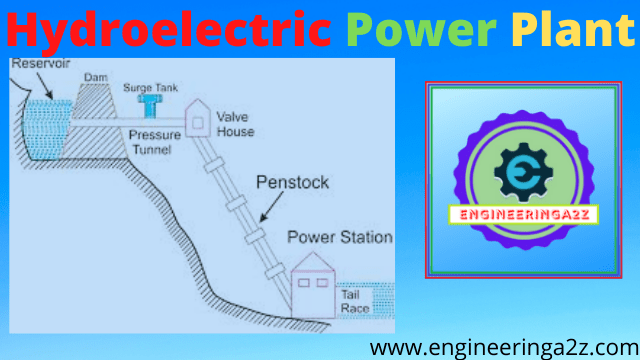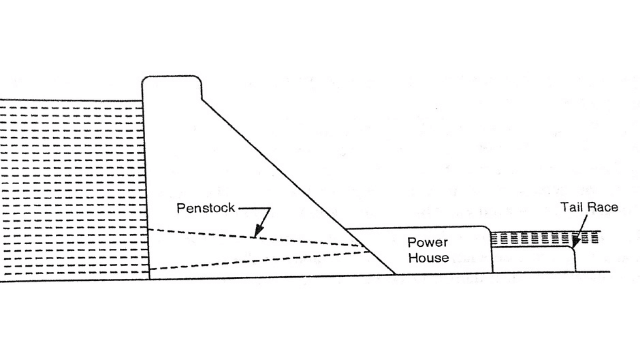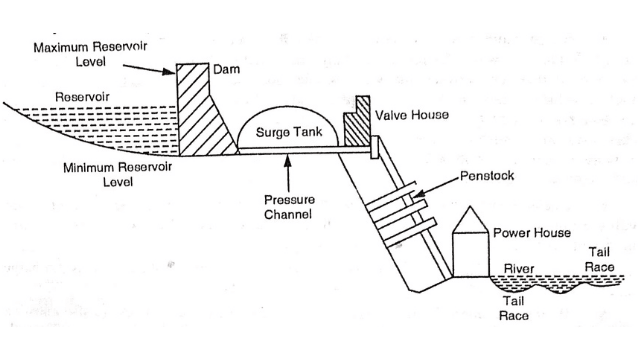
Table of Contents
Definition of Hydroelectric Power Plant
It is a generating station which utilises the potential energy of water at high level for the generation of electrical energy is called hydroelectric power plant.
Hydroelectric Power Plant Working
“ In a hydroelectric power station, water head is created by constructing a dam across a river or lake. From the dam, water is led to water turbine. The water turbine captures the energy in the falling water and changes the hydraulic energy (i.e. product of head and flow of water) into mechanical energy at the turbine shaft. The turbine drives the alternator which converts mechanical energy into electrical energy”. Hydroelectric power stations are generally located in hilly areas where dams can be built conveniently and large water reservoirs can be obtained.

The types of prime movers or turbines used for driving hydroelectric generators depend on the difference of level of water, known as hydraulic head For low heads up to 50 m, vertical shaft Francis turbine is used. Some modified forms of Francis turbines can be used for high heads up to 200 m. and the shafts may be horizontal. For heads above 175 m. usually another prime mover called the Felton wheel is used Kaplin and propeller turbines are also used for low heads.
The generated electric power (P) In Hydroelectric Power Plant can calculated by
Electric Power, (P)= 9.81QHη kW
Where, Q= discharge in mᶟ/s
H=water head in metre
η=efficiency of plant
Hydroelectric Power Plant Diagram

Components of Hydroelectric Power Plant
1. Storage Reservoir
This is the basic requirement of a hydroelectric plant. The purpose of the reservoir is to store water during the rainy season because there is wide variations in water supply from a river or canal, so it becomes necessary to store water by constructing a dam in order to ensure the generation of power throughout the year. The stored water can be supplied to the turbines during dry season and also according to the load on the power plant.
2. Hydroelectric Dam
A Hydroelectric dam is a wall that is made up of concrete. It is used to raise the water level from the ground . The dam is constructed across a river or lake and water catchment area collects at the back of the dam to form a reservoir.
3. Spillways
These are constructed to act as safety valves for a dam. Spill ways serve to discharge the overflow water to the down stream side when the reservoir is full. This condition arises during heavy rainfall in the catchment area. These are generally constructed of concrete piers on the top of the dam. Gates are provided between these piers and surplus water is discharged over the crest of the dam by opening these gates.
4. Pen stock
These are open or closed conduits which carry water from the intake work to the turbines. These are generally made of reinforced concrete or steel reinforced concrete conduits are used where the head is low (< 30 m) where as the steel penstocks can be designed for any head. The thickness of the conduits (Penstock) increases with the head or working pressure.
5. Surge Tank
A surge tank may be considered as an additional storage space near the turbine. Surge tank is usually provided in high head and medium head power plants, where there is considerable distance between the water source and the turbine, which necessitates a long penstock. It is located near the beginning of the conduit. As the load on the turbine decreases or during the reduction of load on the generator, the surge tank provides space for holding water. Similarly when load on the turbine increases, it supplies additional water. Thus, a surge tank controls the pressure variations resulting from the rapid changes in water in penstock and there by prevents water hammering effect.
6. Racks
These are built up from long flat bars set vertically and spaced in accordance with the minimum width of water passage through the turbine. These are provided to prevent the ingress of floating and other material to the turbine.
7. Tail Race
The water after having done its useful work in the turbine is discharged to the tail race which may lead it to the same stream or to any other.
8. Water Turbines
In hydroelectric power stations, water turbines are also known as Prime Movers. The purpose of prime mover is to convert kinetic energy of water into mechanical energy. The commonly used prime movers are Pelton wheel, Francis, Kaplan and propeller turbines.
9. Power house
It is generally located at the foot of the dam and near the storage reservoir. If the power house is near the dam, the loss of head to friction in the penstock would be less.
A power house consists of two main parts:-
- A sub-structure to support the hydraulic and electric equipment.
- A super-structure to house and protect this equipment.
The generating units and exciters are usually located on the ground floor. The turbines which rotate the vertical shaft are placed just below the floor level and those rotating horizontal shaft are placed on the ground floor alongside the generators.
Advantage of Hydro Power Plant
- The running cost of the plant is less as no fuel is used.
- It is very neat and clean.
- It has longer life.
- It has higher efficiency as compared to other type of power plants.
- It helps in irrigation purposes and also for controlling the floods.
- It is a quick starting plant.
Disadvantage of Hydro Power Plant
- It has high capital cost.
- It requires high cost of transmission line.
- It requires skilled and experienced hands to built up the plant.
- Its dependability on the natural rainfall in the catchment area.
Site Selection For Hydro Power Plant
- There should be sufficient quantity of water at a certain height.
- Proper transportation facilities.
- Possibility of stream diversion during construction period.
- Possibility of constructing a dam to store the water at least possible cost.
- Reservoir must have a large catchment area so that level of water in the reservoir may remain above the minimum required in dry season.
- The land should be cheap in cost and rocky.
Read More :
Frequently Asked Questions (FAQ)
-
Why hydroelectric stations have high transmission and distribution cost?
The hydroelectric stations have high transmission and distribution cost because these stations are generally located in hilly areas where the dams can be build conveniently and large reservoirs can be obtained. So the power stations are situated at far away places. To transmit electrical energy from generating station is costly.
-
How many hydro power plants are there in India?
There are 197 hydroelectric power plants in India. For example the chamera Hydroelectric power plant (stage-III) is located in Chamba district of Himachal Pradesh.
-
Which is the largest dam in India?
The largest dam is Tehri Dam and it has height of 260 metre approximately
-
Where the hydroelectric stations are located?
Hydroelectric station are generally located in hilly areas where dams can be built conveniently and large water reservoir can be obtained.











Comments (1)
Have you ever considered publishing an e-book or guest authoring on other blogs?
I have a blog based on the same ideas you discuss and would really like to have you
share some stories/information. I know my readers would value your work.
If you are even remotely interested, feel free to shoot me an e mail.